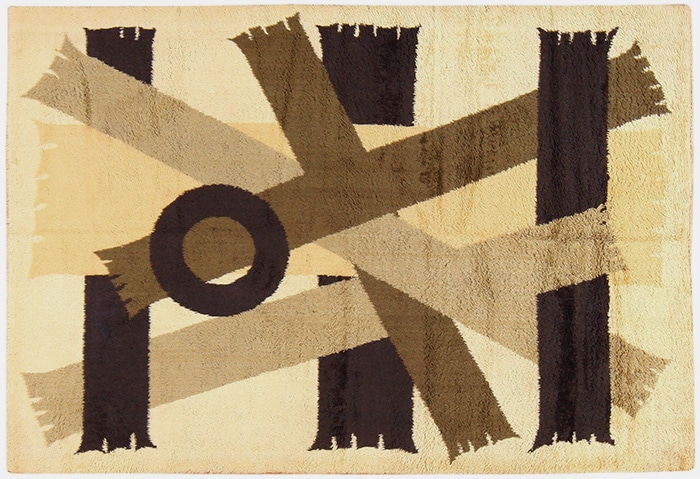History of Vintage Swedish Rya Rug from Scandinavia
Shop Vintage Swedish Rya Rugs | Shop All Rugs From Scandinavia | Shop Swedish Design Area Rugs
Photo Gallery Pictures Of Vintage Swedish Scandinavian Rugs
For starters – what is a rya rug?
A rya rug is a type of traditional Scandinavian rug characterized by its long, shaggy pile and intricate patterns. Rya rugs have a distinct look and feel, making them easily recognizable and highly valued as both functional and decorative textiles.
How are rya rugs made?
The construction and making of a rya rug involves the use of the rya knot technique. Short lengths of yarn are tied onto a woven base, such as a linen or cotton warp, to create a textured surface. The knots are usually left uncut, resulting in a luxurious, plush pile. The length of the pile can vary, but it is typically longer than that of other / different types of area rugs.
Rya carpets are made using a combination of techniques including weaving tapestry, needlework and carpet knots. Swedish Rya rugs were traditionally produced by adding symmetric Turkish / Ghiordes knots directly to the warp through a specially woven backing. Small holes in the weave allowed the craftspeople to insert evenly spaced knots using a large tapestry needle.
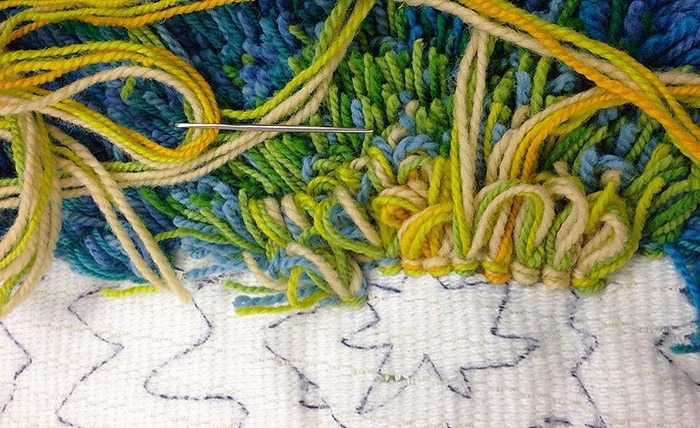
Weaving Shaggy Vintage Swedish Rya Rugs
Where did the rya knot come from?
The term “rya knot” refers to a type of decorative knot used in textiles, particularly in Scandinavian rug-making traditions. However, it’s worth noting that “rya knot” is not a specific knot in the traditional sense. Instead, it refers to a technique used to create a shaggy pile surface on textiles.
The origins of the rya rug knot technique can be traced back to ancient times. The earliest known examples of rug knotting techniques similar to the rya can be found in antique textiles from ancient Egypt, dating back thousands of years. These techniques eventually spread to other regions, including Scandinavia.
In Scandinavia, the rya knot became particularly popular during the Viking Age and medieval times. The technique was used to create warm and insulating rugs, which were essential in the cold climate of the region. Over time, the rya knot developed into a distinctive Scandinavian textile tradition.
While the rya knot technique has its roots in ancient knotting practices, it evolved and became popularized in Scandinavian textile traditions, where it continues to be appreciated and used today.
The knot was similar to the Turkish knot but was an original invention. Warp threads were wool, flax or hemp. The early rugs were made with no design; they were crudely woven, shaggy pieces all in one color. Gradually, zigzag lines, checks and geometric forms appeared.
What does the term “rya” mean?
The term “rya” itself comes from the Swedish word for “rug” or “mat.” Rya rugs are characterized by their long pile, which is created by tying short lengths of yarn onto a woven base. The knots are typically left uncut, resulting in a soft and textured surface. Rya rugs are known for their vibrant colors and intricate patterns, and they have become a significant part of Scandinavian design and folk art.
What are rya rugs known for?
Rya rugs are known for their vibrant colors and elaborate designs. Traditional patterns often feature geometric shapes, abstract motifs, or nature-inspired elements such as flowers, animals, and trees. The colors and patterns used in rya rugs are influenced by the cultural heritage and aesthetics of the Scandinavian region.
What were rya rugs used for originally?
Originally, Swedish Rya rugs were used with the pile down to envelop sleepers in a cocoon of warmth. Early Rya quilts had decorative striped backs and shaggy wool pile in one or two solid colors. Eventually the decoration was reversed and colorful designs were worked into the knotted pile.
Historically, rya rugs were essential in Scandinavian households, as they provided warmth and insulation during the cold winters. They were commonly used as bed coverings or floor coverings in homes. Today, rya rugs continue to be appreciated for their beauty and craftsmanship. They are often considered works of art and are displayed as focal points in interior design, adding texture, color, and a touch of Scandinavian tradition to a space.
Were Rya rugs used as dowry gifts at marriage ceremonies?
There are signed Swedish Rya rugs and those were mostly created for dowries and marriages where they were used in the traditional wedding ceremony. In fact, These rugs were often an important part of the marriage dowry. In Scandinavia, local cultures adapted and changed traditional Islamic art motifs, such as the tree of life design, by changing the symbolism to represent the family tree made up by relatives and past generations. The initials of the couple, the marriage date, double hearts and representations of the bride and groom were often included in the design.
What is the history of the rya rugs?
The introduction of area rugs in Scandinavia
Since the introduction of knotted pile rugs, Scandinavian people have been developing and perfecting their carpet weaving traditions. Although Scandinavians have been making and weaving area rugs since the 14th century, some of the best examples of the art are from the late 19th century when traditional Ryas, and copies of Anatolian designs, reached the height of their popularity.
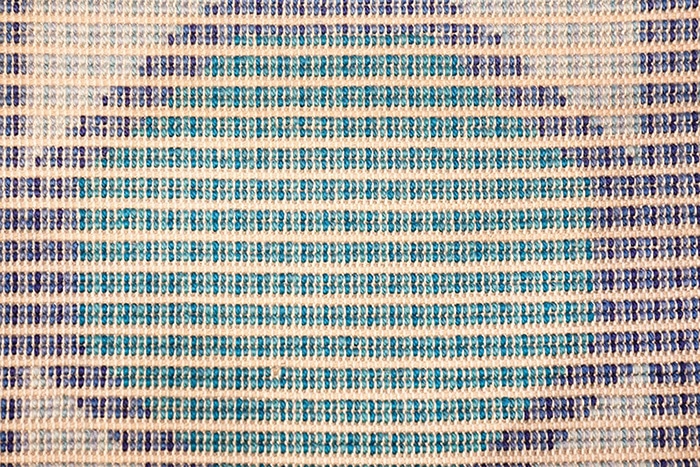
The Back / Weave Of Vintage Swedish Rya Rug
The Danes, Swedes and Norwegians were the “northern people” of the Scandinavian countries. Originally, they spoke a common language and shared similar artistic expressions.
They were simple people who did not travel to foreign lands. As opposed to their European neighbors, court life and the tastes of kings and aristocracy did not dictate their styles and ideas. As a result their customs and art were left untouched from outside influence. As mentioned earlier, these area rug styles were originally intended to be used for warmth as bed covers, cushion covers or wraps rather than on the floor. The area rugs were either flat weave rugs or tapestry weave.

The Shag Pile Of Vintage Swedish Rya Rug #48797
The Scandinavian region became acquainted with rugs at an early period. In the early Middle Ages flat woven kilim rugs and textiles probably found their way home with Viking merchants active in Russia and the Byzantine Empire. In the centuries that followed, such trade ties introduced the knotted pile carpet from Ottoman Turkey.
Indeed, one of the earliest surviving Turkish rugs comes from the parish church at Marby, Sweden. From this early period onward, Scandinavians began to produce rugs for themselves, inspired initially by the imported products, and developing gradually into a distinctive northern idiom.
Flat weave rugs or coverlets became an established type, especially in Sweden, where they came to be known as “Rollakan.” Pile rugs or Ryiji (Rya), often with a long shaggy nap were produce in Norway and Sweden, and above all Finland. The earliest examples are from Norway; these were monochromatic.
9th – 10th centuries
The weavers of Scandinavian rugs and carpets were influenced by carpet weavers in Anatolia and Asia Minor though international trade routes. Between the 9th and 10th centuries, paths were established linking the Varangians or Vikings with the Greek speaking Byzantines in Constantinople.

Vintage Shag Pile Swedish Rya Rugs History
By the year 800, the Byzantines had established themselves as the dominate superpower in Asia Minor, claiming territories that were previously under Roman control. Trans continental and trans oceanic trade routes, through some of the world’s harshest climates, brought the first knotted pile rugs to the Scandinavian countries of Sweden, Norway, Denmark and Finland. Over the next four hundred years, Scandinavians adapted knotted pile carpets to suit the harsh arctic climate.

Thick Shaggy Wool Pile Of A Swedish Rya Rug
14th century
By the 14th century, the Scandinavians had developed their own style of shaggy long pile carpets known as Rya or Ryijy. These thick “new rugs” replaced the thick furs used as floor covering area rugs, cloaks and bed coverings. The unique shaggy texture of the long pile Scandinavian Ryas, provided much needed warmth during the long Nordic winters. Ancient cloaks with fur-like pile have been found in the Viking center of Jornik / York England.
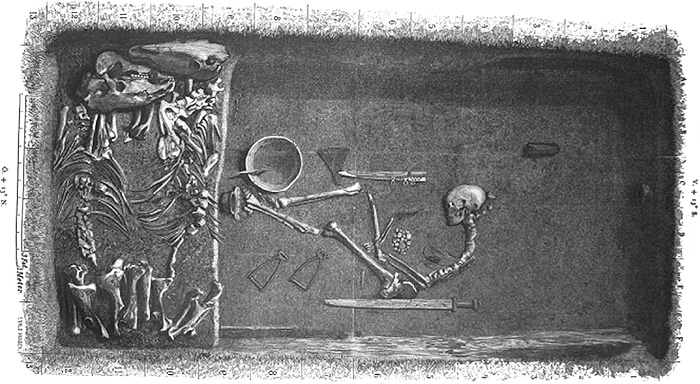
Ancient Viking Warrior Woman Grave at Birka Sweden
Remnants of a blue and red cloaks, shaggy pile (approximately two inches long) were discovered in one the many ancient graves on Sweden’s Birka / Birch Island. Swedish Rya rugs were also adapted as bed coverings and wall hangings by royalty, castle dwellers, as well as commoners and peasants.
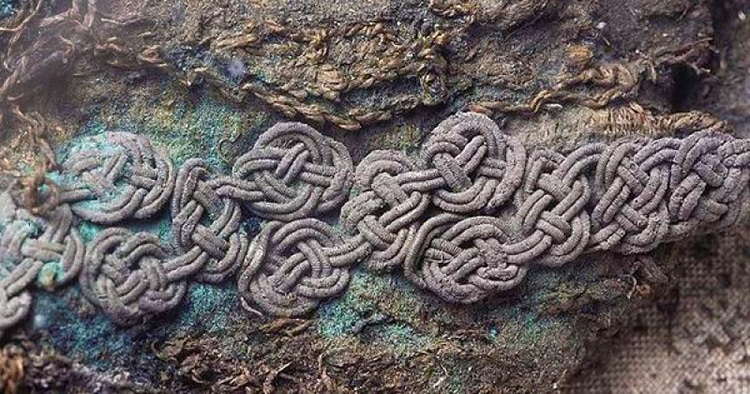
Excavated 10th Century Textile Braiding From A Grave At Birka Sweden
16th century through 19th century
Between 1500’s and late 1800’s, the Scandinavians produced increasingly elaborate carpets and Ryas rugs. They often mimicked the designs of the antique rugs which were imported from Turkey and Anatolia to Finland and other parts of Scandinavia.
20th century
The Scandinavian Rya vintage rugs remained popular throughout the 20th century when designers adopted the shaggy vintage rug to compliment the mid century modern furniture of the 1960’s and 1970’s. Modernist designers, like Danish carpet manufacturer Ege Rya, used ancient abstract motifs borrowed from Moroccan Berber carpets to create shaggy wool carpets with a modern edge.
The historic Marby carpet and the Viking connection
Long before the Danish modern design craze of the 20th century, oriental rugs were important design pieces and functional items in Scandinavia. During the mid 1920’s a historic carpet was discovered in the church of Marby in Jamtland Sweden.

14th Century Marby Carpet From the Met Museum
The so called Marby carpet, which dates back to the late 14th or early 15th century, is important evidence of the carpet trade between the Vikings and the Byzantines. Due to the geometric designs and classic bird in tree motif, historians believe the carpet was produced more than 3,000 miles away in Azerbaijan or Turkey during the early years of the Ottoman empire.
Previously, many historians believed the rug trade was restricted to Italy and countries closer to the carpet making region of Anatolia. The introduction of oriental knotted pile carpets through trade routes was instrumental in the development of the unique Scandinavian style.
Were the rya rugs influenced by Turkish rugs?
Late medieval records suggest that the Swedes tended to import Rya rugs from Finland, but they were made in Sweden as well. The prototypes of these long pile rugs may well have been Turkish, the so-called “Yatak” or bedding rug.
This seems especially likely since the examples of Scandinavian Carpets were also used as bedding insulation. At times they too were woven with pile on both sides for added warmth, like Turkish Yataks. They even display the same kind of bold, graphic patterning as the Turkish examples.
The rya rug history of the designs and patterns
One of the first decorative motifs was the cross as well as some crudely woven human figures. These rugs were unique; no two rugs were the same. Beginning in the mid 17th century the tree of life, flowers (with an emphasis on tulips), birds and animals were introduced.
From the 1600’s on, Swedish Rya rugs were also made with abstractly rendered animal or heraldic imagery, which seems to go back to Medieval European and Oriental traditions, like the Turkish animal carpet from Marby.
Stylized floral designs were also popular. This entire repertoire has survived in Ryas right into the twentieth century, but after 1700, the Rya ceased to be popular among the elite and became a staple of Scandinavian folk culture.
Norwegian examples in the twentieth and nineteenth centuries also came to reflect contemporary western European design, while those made in Sweden and Finland adhered more to the old abstract geometric tradition. Indeed, in these latter areas old patterns continued to be made well into the twentieth century.
After the Second World War, the old style abstraction gave way to modernism, reflecting the prominence of Scandinavian carpets and the mid century modern designers like the Finns, Alvar Aalto and Eero Saarinen.
Are Rya rugs still being made?
Rya rugs are still produced and can be found in various sizes and styles. They are often handcrafted by skilled artisans who follow traditional techniques and patterns, preserving the rich cultural heritage associated with rya rug making.
You may also want to read: 5 Things You Probably Didn’t Know About Vintage Rugs | Choosing Retro Rugs For Your Home Decor | Scandi Home Decor And Scandinavian Interior Design
This rug blog that talks about history of the iconic vintage shag pile Swedish Rya rugs was published by Nazmiyal rugs

